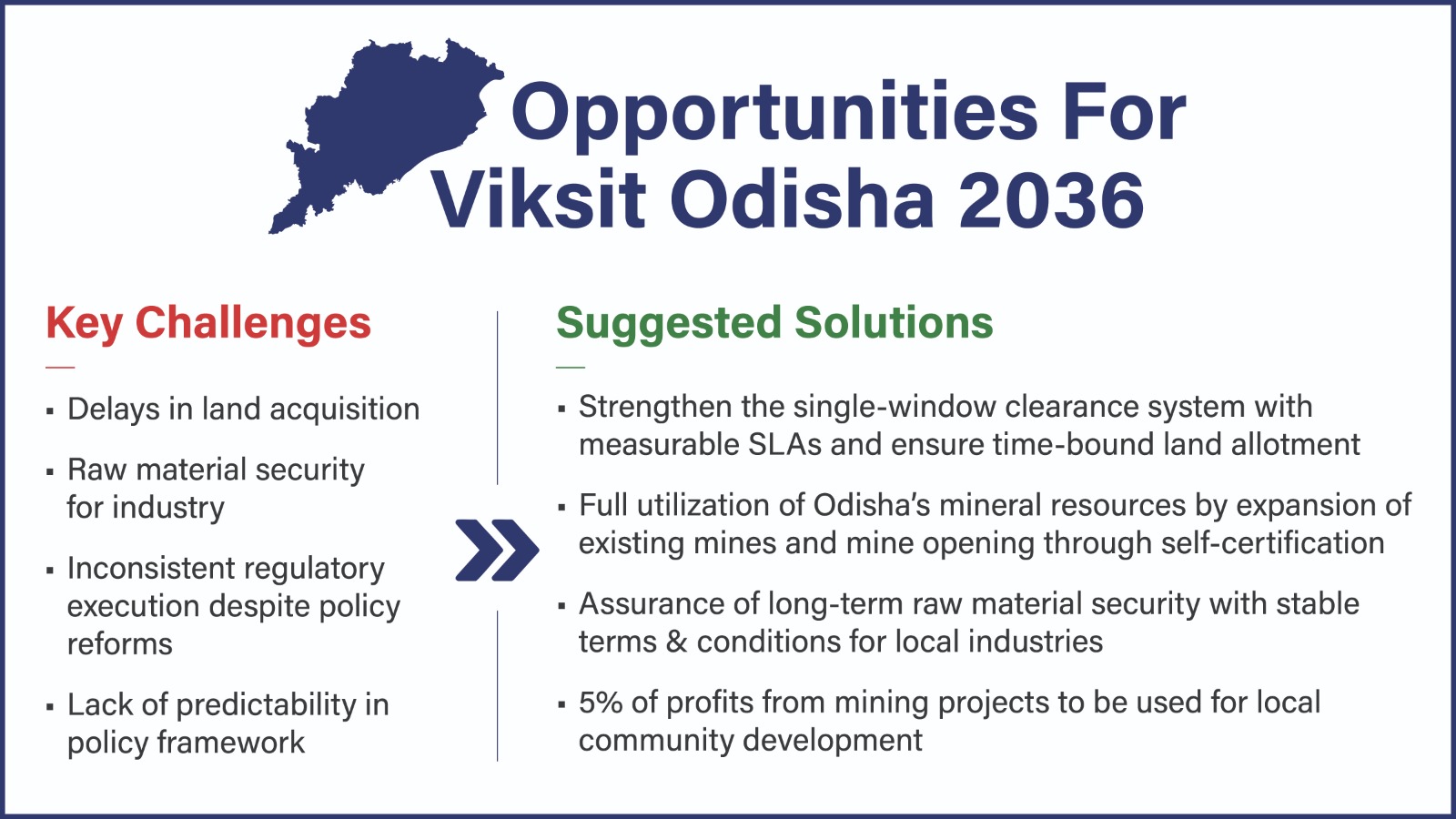THEBUSINESSBYTES BUREAU
BHUBANESWAR, APRIL 8, 2025
Once positioned as a formidable industrial force powered by its rich mineral reserves, Odisha now stands at a pivotal juncture. Despite its remarkable record in attracting large-scale investments — most recently with over ₹1.65 lakh crore approved across districts — concerns are mounting about the state’s ability to sustain its industrial trajectory. At the heart of the issue lies a series of execution roadblocks, including protracted land acquisition, delays in mining project clearances, and an unpredictable regulatory environment. These persistent bottlenecks have triggered calls from former bureaucrats and industry leaders for an urgent overhaul of the policy landscape.
 In a thought-provoking webinar themed “From Bhubaneswar to Bharat: Unlocking Odisha’s Mineral Wealth for Its Social & Economic Prosperity,” organized by Fijeeha, prominent voices from industry and public service came together to urge Odisha to transition from a regulator’s mindset to that of a facilitator. They emphasized the need to align the state’s approach with the national growth narrative and Odisha’s own Viksit Odisha 2036 vision. Despite the state’s strong infrastructure development — including improved connectivity through roadways, ports, and rail networks—the lack of ease in acquiring land and securing clearances has been a deterrent for many investors. Several companies, including AMNS India, BPCL, GAIL, and JSW Steel, have experienced significant project delays due to bureaucratic hurdles, opaque procedures, and local resistance — factors that drive up costs and erode investor trust.
In a thought-provoking webinar themed “From Bhubaneswar to Bharat: Unlocking Odisha’s Mineral Wealth for Its Social & Economic Prosperity,” organized by Fijeeha, prominent voices from industry and public service came together to urge Odisha to transition from a regulator’s mindset to that of a facilitator. They emphasized the need to align the state’s approach with the national growth narrative and Odisha’s own Viksit Odisha 2036 vision. Despite the state’s strong infrastructure development — including improved connectivity through roadways, ports, and rail networks—the lack of ease in acquiring land and securing clearances has been a deterrent for many investors. Several companies, including AMNS India, BPCL, GAIL, and JSW Steel, have experienced significant project delays due to bureaucratic hurdles, opaque procedures, and local resistance — factors that drive up costs and erode investor trust.
Dr. Jayadev Sarangi, former Secretary to the Governments of Delhi and Goa, pointed to the urgency of establishing a dedicated Mineral Facilitation Cell in Odisha. Such an entity would integrate approvals, streamline logistics, and ensure community engagement — critical elements for ensuring smoother land acquisition and stakeholder alignment. He emphasized that meaningful regional engagement must be the foundation of industrial expansion, especially in resource-rich but economically vulnerable regions.
Echoing the sentiment, Dr. Manoj K Dash, Senior Advisor at the Centre for Environment and Development, Bhubaneswar, underscored that Odisha’s mineral reserves, particularly bauxite, are of national importance. However, their true economic value will remain unrealized without expedited mine clearances and operational flexibility. According to him, ensuring timely access to raw materials will not only stabilize operations for existing industries but also serve as a magnet for future investments. A value-centric development approach would also enable localized employment generation and long-term community benefits.
Guruprasad Choudhary, Strategic Advisor at BGR Mining & Infra Ltd, added that policy reforms under the National Manufacturing Mission and ongoing mineral sector initiatives reflect promising intent. Yet, the ground-level impact remains subdued due to excessive delays in the allocation and operationalization of mineral blocks. He advocated for a paradigm shift toward trust-based regulatory frameworks, such as self-certification mechanisms, which would allow businesses to invest and expand with greater certainty.
In comparison, states like Andhra Pradesh and Telangana have emerged as exemplars in industrial facilitation. Their streamlined land and clearance processes, efficient grievance redressal mechanisms, and proactive infrastructure planning offer valuable lessons for Odisha. These states have managed to translate policy into performance, positioning themselves ahead in the race for investments.
Moderating the session, Dr. Nikhil Raj, Development Economist and Director of Sustainable Outcomes Pvt. Ltd., stressed the strategic importance of value addition over raw mineral exports, in line with the Prime Minister’s vision. He noted that Odisha, with its vast mineral wealth, has the potential to become a global hub for metals. However, chronic underutilization of existing plant capacities due to supply uncertainties is a major setback. According to Dr. Raj, bridging this gap through timely mine expansions and fast-tracking approvals could drastically cut down import dependency and improve the state’s industrial output.
Time, the experts emphasized, is of the essence. With rising competition among Indian states for industrial capital, those that can deliver swift approvals, ensure regulatory stability, and create investor-friendly ecosystems will emerge as leaders. Odisha, they said, must urgently translate its promise into performance by resolving key structural challenges.
Among the most pressing reforms proposed were the institutionalization of time-bound land allotment, strengthening of single-window clearance systems with measurable service-level agreements, and stable long-term raw material supply arrangements. The speakers also recommended allowing self-certification for mine expansions, and mandating that five percent of mining profits be reinvested in community development initiatives — a step that would secure the social license to operate and ensure inclusive growth.
As Odisha seeks to realize its industrial potential and cement its place in India’s economic transformation, the message from industry leaders and experts is clear: the state must act decisively and swiftly to create a facilitative environment that not only attracts new investments but also nurtures those already rooted in its mineral-rich soil.
 The Business Bytes
The Business Bytes